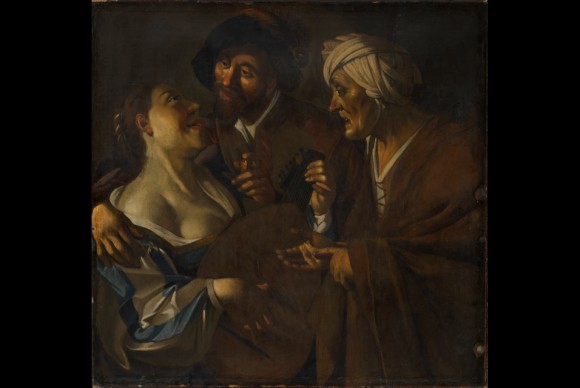The Procuress: Fake or Mistake? Painting Featured in the Third Episode of BBC One’s Fake or Fortune
July 8, 2011 by All Art News
Filed under Opinion & Experiences
LONDON.- The Procuress, the painting featured in the third episode of BBC One’s Fake or Fortune, went on view to the public at The Courtauld Gallery, London, on Monday 4 July 2011, the day after the television programme was broadcast.
In the late 1940s Geoffrey Webb, an officer responsible for the restitution of art seized by the Nazis in Germany and The Netherlands, was given a version of the 17th-century painter Dirck van Baburen’s The Procuress (the original painting, dated 1622, is in the Museum of Fine Arts, Boston). The painting was assumed to be a fake. It had been found in France, in the house of the notorious forger Han van Meegeren (1889-1947). Van Meegeren specialised in forging paintings by Vermeer. He deceived many members of the art establishment and collectors, including the Nazi leader Herman Goering, before being unmasked in a sensational trial in Amsterdam in 1947.
The Procuress was of particular interest to Van Meegeren because Vermeer depicted Baburen’s composition in the background of two of his pictures (A Young Woman Seated at a Virginal, circa 1670-72, London, The National Gallery, and The Concert, circa 1663-66, Boston, Isabella Stewart Gardner Museum [stolen]). Maria Thins, Vermeer’s mother-in-law, owned a painting of The Procuress by Baburen which hung in the house Vermeer shared with his family and mother-in-law in Delft. Her Baburen was probably that now in the Boston Museum of Fine Arts but this painting was only rediscovered in 1949 in an English private collection, and was thus unknown to Van Meegeren.
Van Meegeren maintained that his wife had bought The Procuress in Marseilles and that it was genuine. However, when the painting came into Geoffrey Webb’s possession it was described as a forgery by Van Meegeren. Webb gave The Procuress to The Courtauld in 1960 as a painting by Van Meegeren (along with several drawings by the English baroque architect Nicholas Hawksmoor). He hoped it would be of use to students. Since then, it has been kept for study in the Department of Conservation and Technology. In the late 1970s, however, a researcher suggested the picture might be a 17th-century work.
This hypothesis was put to the test in the BBC programme Fake or Fortune. Technical research for this programme was undertaken by Dr Aviva Burnstock, Head of the Conservation and Technology Department at The Courtauld, and Dr Klaas Jan van den Berg of the Rijksdienst voor het Cultureel Erfgoed, The Netherlands. This confirmed that The Procuress was painted on an old canvas. X-radiography provided evidence that an earlier composition might have been scraped down before the current image of The Procuress was painted. However, analysis (using techniques unknown to earlier researchers) showed that the binding medium mixed with the pigment for the upper paint layers was Bakelite (a modern phenol formaldehyde resin). Van Meegeren is the only documented forger to have used this material, with which he mimicked the effects of aged oil paint. This proves that The Procuress is almost certainly by Van Meegeren.
It therefore seems likely that Van Meegeren’s produced this painting with the intention of claiming it was the version of Baburen’s The Procuress which Vermeer had known, and which is reproduced in two surviving paintings by Vermeer. As such it is a fascinating addition to Van Meegeren’s forgeries of Vermeer.

